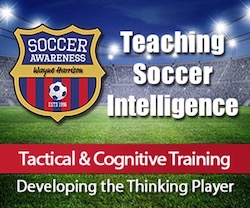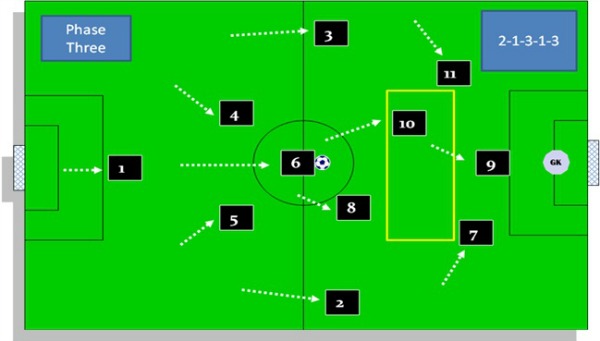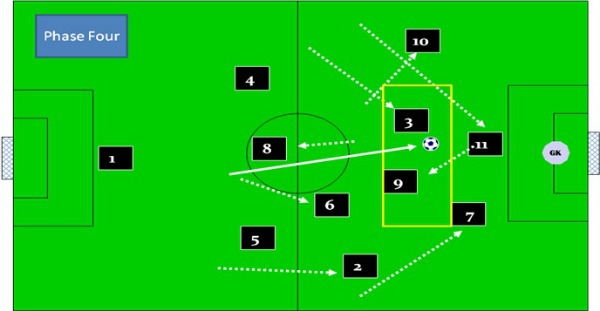How Does the 1-4-2-3-1 Model For Soccer Really Work?
Wayne Harrison, Co-Founder of Soccer Awareness, shares his thoughts on the Power of Positive Reinforcement. Harrison is a former pro soccer player at Blackpool F.C. in the English Championship league.

Harrison was also the Youth Director Al Ain Football Club in the UAE. An author of more than 14 books on soccer coaching as well as 31 eBooks, he now coaches youth soccer, writes and presents at coaching symposiums worldwide.
Harrison holds a UEFA ‘A’ License and the NSCAA Premier Diploma, as well as a bachelor’s degree in applied physiology and sports psychology.
As many of you know, I believe in the 4-2-3-1 system of play. I have written the book Coaching the 4-2-3-1. This system is the favored formation of many top teams in world soccer at both the club and at the national team levels.

This fluid, attack-minded system has come to the forefront thanks to its success at the highest levels. Most notably, Spain utilized the 4-2-3-1 in winning the 2010 World Cup. Top club sides Arsenal, Real Madrid, Inter Milan, and Bayern Munich have also had success with the system.
Read: THE REAL VALUE OF ONE TOUCH MENTALITY
How the 4-2-3-1 system of play works: Is it rigid or is it a free-flowing way of playing soccer?
First, let’s start with some basic terminology ….

Systems of Play: These are just starting positions for the players; every team needs to have a point to build from, and from those positions we can develop vast arrays of movement that are designed to challenge the opposition in many ways.
Style of Play: This is the ‘style’ – defensive, offensive, potion oriented for example – which can be applied within any system of play. The most popular and successful style of play currently in the professional game is one based around very quick 1- and 2-touch passing and movement off-the-ball.
The purpose is to present as many options as possible to the players. The goal is to develop technically great passers and dribblers – and players who know which action to take on the field when.
We want players to use their imagination in 1v1 dribbling situations in the attacking thirds of the field. The 4-2-3-1 is the most free-flowing system of play in the game. Personally, I believe it is important that parents and players both understand the benefits of the 4-2-3-1 system and why we teach it.
The Five Phases of Development Phase One: Defensive Team Shape This is the STARTING POSITION shape for a 4-2-3-1. We number our players from 1 to 11 for simplicity and to help the players’ understanding when we teach them their individual positions.
 |
Phase Two: Attacking Team Shape This is the attacking team shape (attacking “start-position”) for a 4-2-3-1. For U11, U12 and U13 to affect the minds of (7) and (11) we may call it a 4-2-1-3 as a start position so they think in a more positive and an attacking mode to move to this 3-1-3-3.
 |
Phase Three: An Overload in Zone 14 Zone 14 is the area between the opponents’ back three or four and their midfield players and is an area we look to exploit. We want (7) and (11) to cut inside to support (9) and (10), and clear the space wide for (2) and (3) to overlap and join in the attack.
 |
This is the attacking team shape now a 2-1-3-1-3 or 3-1-3-3 depending on the moment. The main change is (6) brings the ball out from the back (or moves forward in attack without the ball) and plays in front of the two center backs.
This can also be the attacking team shape we change to when we are chasing a game perhaps losing 1-0 and wanting to be more positive in attack.
So this now would be our start position. From this very fluid movement, players may end up in very different positions on the field from their own designated start positions.
Look at Wayne Harrison’s Books
The beauty of this means these youth soccer players have to understand other techniques, skills and tactical development to be able to be successful within the game when they move into a new part of the field in a different position.
So all the time just by playing within this system and with this style of play they are learning different positions and what those positions require to be successful; which in the long run will make them far better all-around players.
In other words, the 4-2-3-1 system is absolutely the opposite to perhaps a perceived rigidity in terms of individual and team play for each player. Phase Four: Interchanging Positions in Attack We teach a lot of interchanges between positions.
If the players lose the ball, they have to be turned into being defensively concentrated and disciplined.
 |
As you see from the positions represented by numbers our players have freedom of expression in terms of their movement off the ball.
So we have a staged, pre-planned movement in free play but players’ decision making is based on the opponents’ reaction to these movements.
The end product can be different in each situation.
We offer the 4-2-3-1 framework for the players; we encourage them to make the decisions for themselves within that framework. With this system of play, defenders quickly transition to attacking positions.
As you can see in the above diagram, where our defending back four “wingback” (3) is in a goal scoring position.
Look at Wayne Harrison’s Books
Alternatively, our linking midfielder (8) drops back into defense to cover for the wingbacks attacking should there be a counter attack. So 4-2-3-1 offers up great fluidity of movement for the players in the units and between the units. It is difficult for the opponents to predict where the ball will go next or where particular players will be; due to the fluidity of the style of play within the system.
Phase Five: A FULL team Press in the Attacking Third Our preference is to win the ball back as high as possible and as quickly as possible as shown below.
 |
If the players can’t win the ball immediately, they recover our team shape for a 4-2-3-1 which you can interpret as a 4-1-4-1.
The main thing is we get as many players behind the ball as possible and as quickly as possible.
What are the main components of a successful player development program at a youth soccer club?
- Development models starting at the base of the pyramid and the younger ages.
- Age-Related Coaching and Training Curriculums
- Developing 8 v 8 programs that directly relate to how we play at 11 v 11 effectively teaching 11 v 11 principles at ages 7 and older but on a smaller scale.
- A structured flexible and player orientated 4-2-3-1 System of play that we implement with every team at 11 v 11 from U11 to U19
- Using the Numbers system to identify and explain individual positions.
- A Style of Play throughout the club that all teams will play consisting of ball possession “with a purpose” and vast rotation and freedom of movement of players around the field.
- Structured Coaching Clinics to train and develop the coaches
- A propensity to play quickly and with few touches when the occasion demands involving training teaching players the importance of fast thinking; fast movement; and the importance of developing great decision making (This is also known as the Skill Factor).
- Developing alternative ways to play when the need arises in any game situation.
- Building team from the bottom up
Promotion of players from within the club is one of our long term goals as players all know exactly how to play our system and style at each level and each age group; which means they can easily move to a new team to enhance their player development as needed.
This training not only improves their Soccer Intelligence but it also means the longer they are with us, the greater their understanding, the better they can become.





